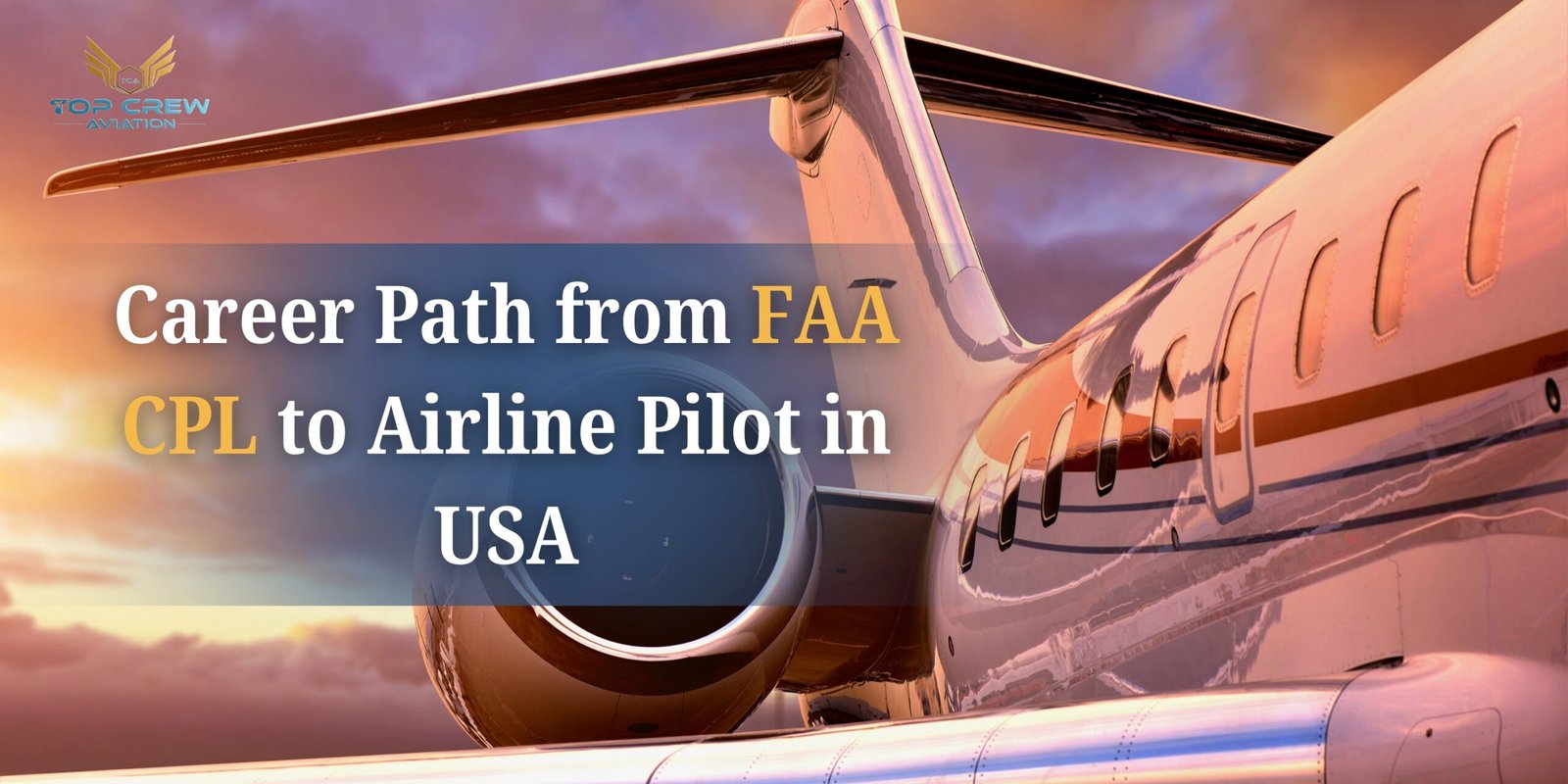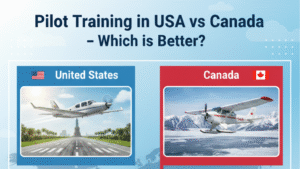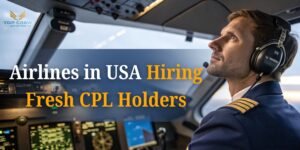What is FAA CPL and Why Does It Matters?
An FAA Commercial Pilot License (CPL) is the first professional-level license that allows a pilot to fly for compensation or hire in the United States. It is issued by the Federal Aviation Administration (FAA) and recognized globally for its high training and safety standards. Once a candidate earns FAA CPL, they legally become a professional pilot, but not yet an airline pilot — because airlines in the U.S. have a higher threshold of experience and qualification.
Why FAA CPL is Important:
- It is the foundation of every commercial pilot career.
- It allows you to get paid for flying (a precondition for hour-building).
- It is the minimum qualification to progress toward ATP (Airline Transport Pilot).
- FAA CPL + US flight experience is highly valued worldwide.
In short: CPL = You can fly professionally.
ATP = You can fly for airlines.
The gap between CPL and ATP is what this career path guide will clarify.
Eligibility Criteria to Become an Airline Pilot in the USA
To eventually qualify for an airline job in the USA, a candidate must meet regulatory, medical, and training requirements.
Basic Eligibility Checklist:
| Requirement | Minimum Standard |
| Age | 18+ for CPL (23 for full ATP) |
| Education | High School / 12th pass (Degree recommended but not mandatory) |
| Medical | FAA Class 1 Medical (for airline readiness) |
| License | FAA CPL with Multi-Engine + Instrument Rating |
| Flight Hours | 1500 (for ATP) |
| Legal Status | Citizen / Green Card / Work Authorization (for airline job) |
Note: You can train in the USA on a student visa, but to work for a US airline, work authorization or citizenship is required.
Career Path After FAA CPL – Step-by-Step Guide
Here is the full structured roadmap most successful U.S. airline pilots follow:
| Stage | License / Experience | Purpose |
| Step 1 | FAA CPL + IR + Multi | Commercial flying eligibility |
| Step 2 | CFI / CFII / MEI (Optional but common) | Fastest hour-building |
| Step 3 | Build 1500 flight hours | Required for ATP |
| Step 4 | ATP-CTP course | Airline Transport Pilot transition |
| Step 5 | FAA ATP Checkride | Legally eligible for airline |
| Step 6 | Apply to Regional Airline | First airline job |
| Step 7 | Upgrade to Captain / Move to Major Airline | Seniority & career growth |
This is the standard USA airline pipeline followed by 95%+ pilots.
Suggestion Blog URL:- Pilot Training Cost Comparison in India and Other Countries.
How to Build 1500 Flight Hours
After CPL, the primary challenge is flight experience. The FAA requires 1500 total time before you can attempt the ATP exam.
Common Hour-Building Methods
| Method | Description | Why Pilots Choose It |
| Flight Instructor (CFI/CFII/MEI) | Teach student pilots | Fastest & lowest-cost hour building |
| Banner Towing | Advertising flights | Seasonal, good hours in summer |
| Aerial Survey | Photography / mapping | Long cross-country flying |
| Part 135 Operations | Charter / cargo | Seats you earlier in commercial ops |
Flight Hour Summary
| License | Typical Hours | Running Total |
| CPL Graduates With | 250 hours | 250 |
| Instructor Builds | 1000–1200 hours | 1200–1450 |
| Remaining Fatigue / Ferry Hours | 50–300 | 1500 |
Most pilots reach 1500 hours within 12–18 months through flight instruction.
Why CFI / CFII / MEI Is the Fastest Track
Becoming a flight instructor is the most common and financially efficient way to move from CPL to airline-ready.
Benefits of Instructor Route:
- You get paid while building hours.
- Constant flying → continuous recency and skill improvement.
- High cross-country + PIC time (valued by airlines).
- Smooth transition to Instrument (CFII) & Multiengine (MEI) ops.
Typical Instructor Progression
- CFI – Teach private & commercial students
- CFII – Teach instrument flying
- MEI – Teach multiengine students (high-value time)
This route not only accelerates hour-building, but also improves your aeronautical decision-making, which becomes crucial in airline interviews.
Airline Transport Pilot (ATP) Requirements in the USA
The ATP license is the final qualification you need before joining a U.S. airline as a First Officer. FAA rules require all airline pilots to hold an ATP (or Restricted ATP in some cases).
Minimum ATP Requirements
| Requirement | Minimum Standard |
| License | FAA CPL with Multi Engine + Instrument |
| Flight Time | 1500 total hours (or 1250/1000 via restricted ATP categories) |
| Medical | FAA Class 1 |
| Training | ATP-CTP Course (mandatory) |
| Exam | ATP (FAA written + checkride) |
| Age | 23 (or 21 for r-ATP) |
ATP-CTP Course = Airline Transport Pilot Certification Training Program
This is a prerequisite before taking the ATP written exam and includes advanced airline-level procedures, jet systems, CRM, and Level-D simulator exposure.
Once you pass ATP checkride → You are now airline-eligible.
Career Ladder: Regional vs Major Airlines (Career Progression Chart)
In the USA, most pilots do not directly join United / Delta / American Airlines right after ATP. They usually start with regional airlines, gain experience, and then upgrade.
Career Progression Flowchart
FAA CPL → CFI/Hour Building → 1500 Hours → ATP → Regional Airline FO
→ Regional Airline Captain → Apply to Major Airline (United/Delta/American)
→ Major Airline First Officer → Widebody Captain (Long Haul)
Role Comparison
| Stage | Airline Type | Position | Typical Aircraft |
| First Job | Regional | First Officer | Embraer / CRJ |
| Mid Career | Regional | Captain | Embraer E175 / CRJ-900 |
| Upgrade | Major Airline | First Officer | B737 / A320 / B787 / A350 |
| Final Stage | Major Airline | Captain | B787 / A350 / B777 / A330 |
Regional = Gateway → Major Airline.
This is the standard pathway in US aviation.
Salary Growth from CPL to Captain in USA (Table)
Pilot salaries in the USA rise sharply once a pilot moves from CPL → ATP → Airline cockpit. Here is a realistic breakdown:
| Career Stage | Approx Experience | Typical Salary (Annual) |
| Fresh CPL (before ATP) | 250 hrs | $0 – $35,000 (hour building / instructor pay) |
| Flight Instructor (CFI/CFII/MEI) | 500–1500 hrs | $35,000 – $70,000 |
| Regional Airline First Officer | 1500+ hrs | $80,000 – $120,000 |
| Regional Airline Captain | 3000+ hrs | $120,000 – $180,000 |
| Major Airline First Officer | 4000+ hrs | $180,000 – $250,000+ |
| Major Airline Captain (Widebody) | 7000+ hrs | $280,000 – $350,000+ |
The US is one of the highest paying aviation markets worldwide because pilots are unionized and protected by seniority rules.
Common Challenges Faced After CPL
Although the USA pathway is structured, it also has practical challenges:
Major Challenges
- Getting to 1500 hours without overspending
- Visa/work authorization (for non-citizens)
- Finding right school/employer for CFI
- Competitive hiring in major airlines
- Maintaining Class 1 medical
- Seasonal flying opportunities
How Pilots Overcome Them
- Becoming CFI early → steady income + hours
- Networking with flight schools → guaranteed flying slots
- Maintaining medical fitness regularly
- Structured resume + logbook preparation
- Building multi-engine time strategically
Final Roadmap: From FAA CPL to Airline Cockpit
Here is the step-by-step final roadmap in a single view:
| Stage | Action | Outcome |
| 1 | Finish FAA CPL (with IR + Multi) | Eligible to work as pilot |
| 2 | Add CFI/CFII/MEI ratings | Start earning + build hours |
| 3 | Accumulate 1500 total time | Qualify for ATP |
| 4 | ATP-CTP Course | ATP written eligibility |
| 5 | Pass ATP Checkride | Airline-ready |
| 6 | Join Regional Airline as FO | Airline entry |
| 7 | Upgrade to Captain → Move to Major Airline | Career growth & higher salary |
Suggestion Blog URL:- FAA Pilot License Explained – PPL, CPL & ATPL
Conclusion
Becoming an airline pilot in the USA is a structured, transparent, and highly rewarding career path — but it requires planning beyond just obtaining a Commercial Pilot License. The real transition begins after CPL, when a pilot starts building meaningful experience toward the 1500-hour ATP threshold. The combination of FAA CPL → Flight Instruction → ATP → Regional Airline is the standard and fastest way to enter a U.S. airline cockpit.
Once inside the system, pilots benefit from stable seniority, union protection, world-class salary packages, and global flying opportunities. With proper licensing, medical fitness, and consistent hour-building, a pilot can progress from FAA CPL to regional First Officer in 18–24 months — and to a major airline within a few additional years.
If you are planning to build a long-term pilot career in the U.S., understanding this roadmap early gives you a major advantage in planning finances, training milestones, and hiring timelines.



